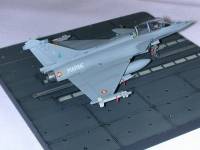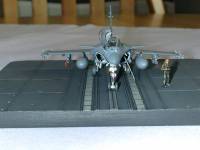Aeronavale "Top Gun"By Bruce Simard |
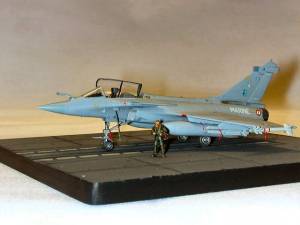
|
Background
France’s “Rafale”, or storm, is their new “Top Gun” aboard their carrier, The FNS Charles deGaulle. Several years ago, Revell produced a beautiful 1/48th scale model of it. The following year, they released a 1/144th scale version. This kit, folks, is an absolute jewel. It really did set a new level for manufacturers to attain. For the first real time, 1/144th had a model that was comparable in detail to the 1/72nd scale. In my opinion, it really looks like they pantographed it down from their 1/48th scale kit, it really is that good. Other than the fact 1/144th isn’t that popular, I’ve been surprised we haven’t seen more of them built up. But perhaps modelers just don’t realize what a jewel they are missing, this article may help to make them aware. Admittedly, a better modeler could really make this bird shine, but for now, you’re stuck with me. So let’s see what we have.
History
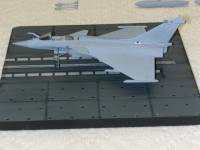 In
June,1982, Dassault Aviation announced the successor to the Mirage 2000
would be the “ACX” program. What was finally to become the
Rafale was born. I will not review all the political problems, as well
as financial in the early program. Like all 4th generation
fighters, it has had its share of all of these. But M01, the first naval
prototype took to the air on December 12,1991. This finally allowed the
Aeronavale to start seriously planning for the retirement of the F-8N
Crusader ! And needless to say, this was an incredible leap in technology
and capabilities in one step. So much so, the French Navy sent some of
it’s pilots to train with the Air Force on the Mirage 2000. This
would allow them to get a better handle with the technology prior to the
Rafale’s introduction. The Air Force will also be getting the Rafale
in both single seat and dual seat versions. At present, they are scheduled
to receive approximately 234 examples, while the Navy will get approximately
86 Rafales.
In
June,1982, Dassault Aviation announced the successor to the Mirage 2000
would be the “ACX” program. What was finally to become the
Rafale was born. I will not review all the political problems, as well
as financial in the early program. Like all 4th generation
fighters, it has had its share of all of these. But M01, the first naval
prototype took to the air on December 12,1991. This finally allowed the
Aeronavale to start seriously planning for the retirement of the F-8N
Crusader ! And needless to say, this was an incredible leap in technology
and capabilities in one step. So much so, the French Navy sent some of
it’s pilots to train with the Air Force on the Mirage 2000. This
would allow them to get a better handle with the technology prior to the
Rafale’s introduction. The Air Force will also be getting the Rafale
in both single seat and dual seat versions. At present, they are scheduled
to receive approximately 234 examples, while the Navy will get approximately
86 Rafales.
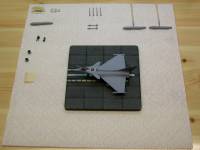 An
interesting side line is the mix of single and dual seats for both services.
After the 1991 Gulf war, several air forces, France among them, recognized
the single pilot was becoming over tasked in today’s environment.
Even with all the new bells and whistles in the cockpit, a human’s
attention can only be divided so far. Consequently, 60 % of the French
Air Force order would be for the twin seat, with the Navy considering
the same. However, lately this seems to be swinging back in favor of the
single seat as the financial problems once again kick in. This same situation
seems to be prevalent with most Air Forces today.
An
interesting side line is the mix of single and dual seats for both services.
After the 1991 Gulf war, several air forces, France among them, recognized
the single pilot was becoming over tasked in today’s environment.
Even with all the new bells and whistles in the cockpit, a human’s
attention can only be divided so far. Consequently, 60 % of the French
Air Force order would be for the twin seat, with the Navy considering
the same. However, lately this seems to be swinging back in favor of the
single seat as the financial problems once again kick in. This same situation
seems to be prevalent with most Air Forces today.
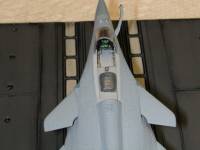 Flottile
12F received its first Rafale in December 2000. Since then, it has now
reached its full compliment of aircraft. These aircraft were delivered
to the F1 avionics standard (Air Defence), with F2's now under development
(Multi-role). 12F has now taken her brood aboard the boat, and proved
to be extremely tough adversaries for friendly acm challenges. A recent
article I read stated how the Rafale proved to be a nasty surprise for
USN legacy Hornet drivers. The combination of Rafale, Magic, and Mica
missiles is proving to be a potent mixture. This combined with the Aeronavale’s
purchase of E2C’s for AEW has really provided them with a potent
mixture of aircraft and technology.
Flottile
12F received its first Rafale in December 2000. Since then, it has now
reached its full compliment of aircraft. These aircraft were delivered
to the F1 avionics standard (Air Defence), with F2's now under development
(Multi-role). 12F has now taken her brood aboard the boat, and proved
to be extremely tough adversaries for friendly acm challenges. A recent
article I read stated how the Rafale proved to be a nasty surprise for
USN legacy Hornet drivers. The combination of Rafale, Magic, and Mica
missiles is proving to be a potent mixture. This combined with the Aeronavale’s
purchase of E2C’s for AEW has really provided them with a potent
mixture of aircraft and technology.
The Kit
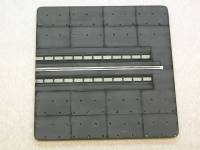 OK,
so what do we get with Revell’s kit # 04033 ? The kit consists of
approximately 58 pieces in grey plastic, plus the clear canopy. This kit
has extremely petite panel lines scribed in, which is a testimony to the
skill of the mold makers. Just as with 1/72nd scale, one has to be careful
in construction. If you get ham handed with glue or filler, these beautiful
lines will disappear. Now don’t misunderstand me, I do not consider
this a “perfect” kit - there is no such thing. But for 1/144th
scale, this is about as close as we can expect.
OK,
so what do we get with Revell’s kit # 04033 ? The kit consists of
approximately 58 pieces in grey plastic, plus the clear canopy. This kit
has extremely petite panel lines scribed in, which is a testimony to the
skill of the mold makers. Just as with 1/72nd scale, one has to be careful
in construction. If you get ham handed with glue or filler, these beautiful
lines will disappear. Now don’t misunderstand me, I do not consider
this a “perfect” kit - there is no such thing. But for 1/144th
scale, this is about as close as we can expect.
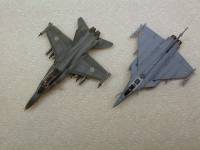 From
the way the mold is cut, I have no doubt a two seat will follow. And since
both the Air Force and Navy will be getting them, Revell will get a good
bang for their buck. There are a few areas to watch for, however. I found
the fit of the nose gear well to be a little troublesome. But this could
also be my aging eyeballs, and fat fingers. I also used a minute amount
of filler at the wing to fuselage joint. Not really bad, just needed a
better blend. The wheel wells are about as detailed as you can get in
this scale, paint and wash them prior to assembly. The cockpit area comes
with a passable tub, good ejection seat, and a beautiful instrument panel.
All of these pieces obviously benefit from careful painting and highlighting.
On my example, I also added the wide angle HUD from clear plastic. Two
side stick controllers were added from sprue.
From
the way the mold is cut, I have no doubt a two seat will follow. And since
both the Air Force and Navy will be getting them, Revell will get a good
bang for their buck. There are a few areas to watch for, however. I found
the fit of the nose gear well to be a little troublesome. But this could
also be my aging eyeballs, and fat fingers. I also used a minute amount
of filler at the wing to fuselage joint. Not really bad, just needed a
better blend. The wheel wells are about as detailed as you can get in
this scale, paint and wash them prior to assembly. The cockpit area comes
with a passable tub, good ejection seat, and a beautiful instrument panel.
All of these pieces obviously benefit from careful painting and highlighting.
On my example, I also added the wide angle HUD from clear plastic. Two
side stick controllers were added from sprue.
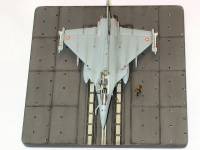 Armament
is catered for with 2 Majic , and 4 Mica missiles. Remember, this is actually
the Air Defence version. Here you have another choice. The F1's as currently
flown, do not have the nose sensors installed. These are to be added for
the F2 multi-role version, which is in development as we read this. I
added these sensors to mine, since most of the F1's will be refitted as
F2's eventually. The large fuel tanks are given in the kit. The molding
on these is terrific. Since they have a unique shape, (almost area ruled)
I definitely wanted them on my kit.
Armament
is catered for with 2 Majic , and 4 Mica missiles. Remember, this is actually
the Air Defence version. Here you have another choice. The F1's as currently
flown, do not have the nose sensors installed. These are to be added for
the F2 multi-role version, which is in development as we read this. I
added these sensors to mine, since most of the F1's will be refitted as
F2's eventually. The large fuel tanks are given in the kit. The molding
on these is terrific. Since they have a unique shape, (almost area ruled)
I definitely wanted them on my kit.
The canopy is very well done and extremely clear. As is my normal routine, I backfilled and vacuformed a new one. This is done so I can display the canopy in the open position. (A mechanic’s mentality, folks) Plus the rear wall of the canopy assembly was added from plastic stock.
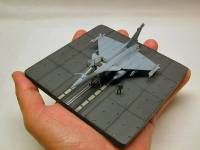 The
decals included give you a choice of the Rafale prototype, or the markings
for Flotille 12F. I chose to use the operational markings. This also brings
up another interesting point. In most of the photos I’ve seen, the
national markings seem to be going through a change. France has normally
used full color, but reduced in size markings. Lately, it almost seems
the Aeronavale will put on the markings, then over spray paint to subdue
them. These are from the latest photos I’ve seen. The Rafale colors
are another point of interest. I’ve read on several digests, the
best guess on the blue grey used. I used Testor’s acrylic light
French blue grey, I’m satisfied with the results.
The
decals included give you a choice of the Rafale prototype, or the markings
for Flotille 12F. I chose to use the operational markings. This also brings
up another interesting point. In most of the photos I’ve seen, the
national markings seem to be going through a change. France has normally
used full color, but reduced in size markings. Lately, it almost seems
the Aeronavale will put on the markings, then over spray paint to subdue
them. These are from the latest photos I’ve seen. The Rafale colors
are another point of interest. I’ve read on several digests, the
best guess on the blue grey used. I used Testor’s acrylic light
French blue grey, I’m satisfied with the results.
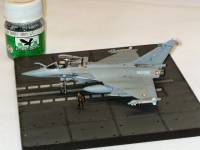 As
you can see from the photos, weathering was kept to a minimum. Folks,
when you only get a new aircraft every 30+ years or so, better take care
of it ! From the photos, you can see my Rafale was placed on a section
of carrier deck. This came from the DML F-14/F-18 carrier deck kits from
quite a few years ago. The figure came from Preiser’s 1/144th modern
German Air Force, suitably modified. This was interesting to say the least.
Trying to paint 1/144th “Speed Jeans”(G suit) on this figure
about crossed my eyes. Plus since he is an Aeronavale “Top Gun”
- he just had to have his sun glasses on ! Even though this was a pain,
in the end it was worth it to me. You might also notice the landing lights
on the nose. These are railroad jewels. I prefer to use these on 1/144th
models.
As
you can see from the photos, weathering was kept to a minimum. Folks,
when you only get a new aircraft every 30+ years or so, better take care
of it ! From the photos, you can see my Rafale was placed on a section
of carrier deck. This came from the DML F-14/F-18 carrier deck kits from
quite a few years ago. The figure came from Preiser’s 1/144th modern
German Air Force, suitably modified. This was interesting to say the least.
Trying to paint 1/144th “Speed Jeans”(G suit) on this figure
about crossed my eyes. Plus since he is an Aeronavale “Top Gun”
- he just had to have his sun glasses on ! Even though this was a pain,
in the end it was worth it to me. You might also notice the landing lights
on the nose. These are railroad jewels. I prefer to use these on 1/144th
models. 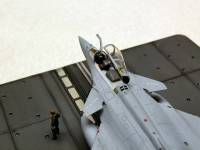 The
reason is, although MV lens are more realistic, the jewels tend to “wink”
at you from just about any angle. This will get folks attention, plus
makes it a little unique. The boarding ladder was added from scratch.
I’m not quite sure about the exact configuration of this. Most of
the photos I’ve found were tough angles for details. The “Remove
before flight” streamers were made from thin strips of aluminum
foil, painted and attached.
The
reason is, although MV lens are more realistic, the jewels tend to “wink”
at you from just about any angle. This will get folks attention, plus
makes it a little unique. The boarding ladder was added from scratch.
I’m not quite sure about the exact configuration of this. Most of
the photos I’ve found were tough angles for details. The “Remove
before flight” streamers were made from thin strips of aluminum
foil, painted and attached.
Included in the photos is one of a comparison of the size of the Rafale with a Canadian CF-188B. As you can see, it really isn’t a large aircraft. This helps because the Rafale does not have folding wings for the naval version, and space is always at a premium aboard the boat.
Summary
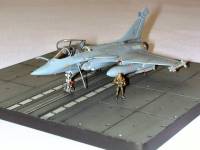 Overall,
I really enjoyed this kit, and that is the most important thing. Revell
is really coming on strong with the smaller scales, and taking it seriously.
As always, constructive criticism from the readership is definitely appreciated.
Until next time, enjoy!
Overall,
I really enjoyed this kit, and that is the most important thing. Revell
is really coming on strong with the smaller scales, and taking it seriously.
As always, constructive criticism from the readership is definitely appreciated.
Until next time, enjoy!
References
Air Forces Monthly......................................December 2003
World Airpower Journal..............................Volume 18, Fall 1994
